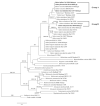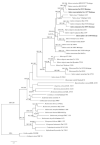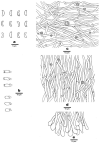Global Diversity and Taxonomy of Sidera (Hymenochaetales, Basidiomycota): Four New Species and Keys to Species of the Genus
- PMID: 33810364
- PMCID: PMC8066320
- DOI: 10.3390/jof7040251
Global Diversity and Taxonomy of Sidera (Hymenochaetales, Basidiomycota): Four New Species and Keys to Species of the Genus
Abstract
The genus Sidera is a polypore genus with resupinate, white to cream or buff fresh basidioma, poroid or hydnoid hymenophore, a monomitic or dimitic hyphal system with generative hyphae bearing clamp connections, the presence of rosette-like crystals and allantoid to lunate basidiospores. We study the phylogeny and diversity of Sidera herein by using both morphological and molecular methods. Phylogenetic analyses are based on the ITS dataset, the combined 2-locus dataset (5.8S + nLSU) and 7-locus dataset (ITS + nLSU + RPB1 + RPB2 + TEF1 + mtSSU + nSSU) of 15 taxa of Sidera all over the world. Among them, four species are new to science and described and illustrated in this paper, viz. S. inflata, S. malaysiana, S. punctata and S. roseo-bubalina. In addition, three taxa were treated as Sidera vulgaris sensu lato. An identification key of the 14 accepted species of Sidera worldwide is provided.
Keywords: Rickenellaceae; phylogenetic analysis; wood-rotting fungi.
Conflict of interest statement
The authors declare that there are no conflict of interest.
Figures











References
-
- Miettinen O., Larsson K.H. Sidera. A new genus in Hymenochaetales with poroid and hydnoid species. Mycol. Prog. 2011;10:131–141. doi: 10.1007/s11557-010-0682-5. - DOI
-
- Fries E.M. Systema Mycologicum. Berlingius Lindae. 1821;1:1–520.
-
- Rajchenberg M. Type studies of Polyporaceae (Aphyllophorales) described by J. Rick. Nord. J. Bot. 1987;7:553–568. doi: 10.1111/j.1756-1051.1987.tb02023.x. - DOI
-
- Bourdot H., Galzin A. Hyménomycètes de France. I. Hétèrobasidiés. Bull. Soc. Mycol. Fr. 1909;25:15–36.
Grants and funding
LinkOut - more resources
Full Text Sources
Other Literature Sources

